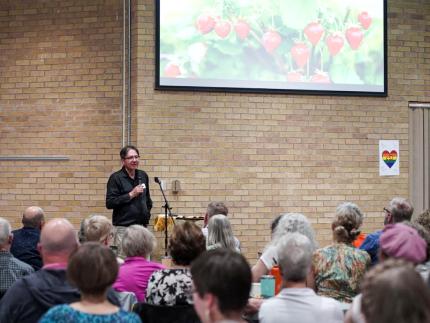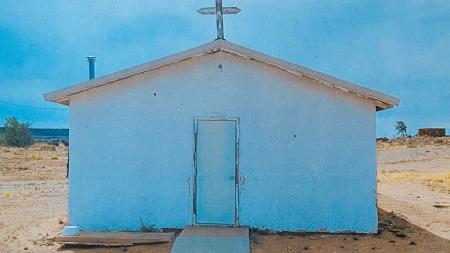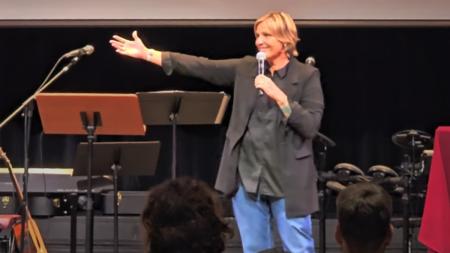A Feast of Gratitude and Covenant

It all started in 2007 over lunch.
Ganosono, also known by his “Canadian settler name,” Adrian Jacobs, a Christian pastor from the Turtle Clan, Cayuga Nation, was sharing a meal with Rick Hill, a knowledge-keeper from the Beaver Clan, Tuscarora Nation. Both men are from the Six Nations
Haudenosaunee Confederacy of the
Grand River Territory. Hill posed a question that would change the course of Jacob’s ministry: “Do the churches pay taxes?”
Knowing he was referring to property taxes, Jacobs said, “No.” And Hill responded, “Good. Wouldn’t it be great if the churches had a spiritual covenant with Six Nations where they could acknowledge Six Nations jurisdiction over their church lands, pay a token lease payment, and continue their spiritual work—and if the churches ever decommissioned, the land could revert back to Six Nations?”
“Those words were burned into my heart at that time,” Jacobs recalled.
Today that seed of an idea has grown into a blossoming, hope-filled movement of non-Indigenous churches walking together with First Nations people in a spirit of right relationship.
Strawberry Thanksgiving and Communion
On June 14, 2025, over 170 people from 11 Christian denominations and from the Six Nations Confederacy gathered for the fourth annual Strawberry Thanksgiving and Communion event at Rockway Mennonite Collegiate, a high school in Kitchener, Ont. What began as a dream in 2007 has become an ecumenical celebration of land, gratitude, and relationship rooted in both Haudenosaunee traditional teachings and Christian theology.
“It's good for First Peoples and settler peoples to do things together and learn more about each other. To have a greater understanding of what has happened in the past and what we can do moving forward,” said Mim Harder, a KAIROS Blanket Exercise facilitator with Mennonite Central Committee Ontario.
The timing was intentional—June is when strawberries, the firstfruits of Haudenosaunee culture, are harvested. “Strawberries are medicine, food, and ceremony,” Jacobs explained. “We give thanks for what Creator has provided.”
Communion, he added, “is also thanksgiving—joining together in recognition of Christ and the provisions of Creator.”
The gathering opened with the Haudenosaunee Thanksgiving Address, honoring the land, sun, animals, water, and all creation. Jacobs shared some reflections on the importance of “covenant” in both Christian and Indigenous teachings. He reminded participants that if the Haldimand Tract lands—granted to Six Nations in 1784 by the British Crown—had been properly leased, Six Nations communities could have earned between $2 to $7 trillion in interest by now.
This year’s event brought fresh symbolism and deepened commitments. Stirling Avenue Mennonite Church (Kitchener, Ont.), one of the first to enter into a spiritual covenant as Hill envisioned, presented a handcrafted pottery communion set to Jacobs. Designed by artist and congregant Katie Cowie-Redekopp, the ceramic vessels feature strawberry plants as a visual and spiritual symbol.
“In consultation with Adrian, I chose the strawberry because of its sacred place in Haudenosaunee culture,” Cowie-Redekopp said. “Strawberry plants have deep roots, a wide network of runners and leaves—just like reconciliation work. It spreads. It transforms.”
As part of the spiritual covenant, churches are encouraged to make token lease payments to Indigenous peoples. Six Nations Polytechnic was identified as a good place to direct these payments. A nonpartisan, Indigenous-led educational institution cofounded by Hill, Six Nations Polytechnic preserves and revitalizes Haudenosaunee language and knowledge.
But the covenant is more than financial—it’s relational. “This isn’t about guilt,” Jacobs reminded attendees. “It’s about relationships and beginning a journey, however small the first step may be.”
To symbolize the Indigenous-settler dialogue, this year’s ceremony was cofacilitated by Laurie Warkentin, a Mennonite staff person from MCC Ontario, and Lana Moses, of Lenape and German ancestry, from Feather & Cross, a Lutheran-based organization dedicated to learning about Indigenous culture. Together they represented the strength and leadership of women and the call for side-by-side journeys of mutual respect.
Broadening Support from Local Churches
Churches from various backgrounds are participating in the idea of spiritual covenant as word spreads to more communities on and around the Haldimand Tract. Wilda Thumm shared that First Baptist Church in Guelph, Ont., is interested because “people feel overwhelmed – it's such a big problem! But now we know about this concrete way for a congregation to do something.”
Meadowlands Fellowship Christian Reformed Church in Ancaster, Ont., shared that 45 members participated in the learning journey Hearts Exchanged, which led individual donors from their congregation to contribute the bulk of a symbolic 1 percent of their church’s budget to Six Nations Polytechnic in the first year, with a plan for their church to cover an increasing amount so that, by year five, the full donation would be from their church’s budget. This allows those already engaged to start while giving time to raise awareness within their wider congregation as they work toward full funding.
Other churches that have long been working toward reconciliation are recognizing the spiritual covenant as a way to take action. Southridge Community Church in the Niagara region has had a “Becoming Good Relatives” working group for a number of years. As they work on engaging the whole congregation in conversations of financial repair through different learning opportunities, they are connecting locally with Indigenous organizations.
Waterloo North Mennonite Church shared how they have been responding to the Truth and Reconciliation Commission Call to Action #59 to “learn about their church’s role in colonization, the history and legacy of residential schools, and why apologies to former residential school students, their families, and communities were necessary.” Now their collective learning will continue as they build relationships with Six Nations.
In 2017, Parkminster United Church in Waterloo, Ont., started a journey of relearning history and what it means to live in right relationship. Nancy Dykstra, a church leader, reflected that “there have been swells and dips in interest. But the Strawberry Thanksgiving and Communion came at a providential time. It reminded us we’re not alone.”
Thanks to follow-up support from the CRC and MCC, congregations such as Parkminster have been able to deepen their understanding and continue the conversation. “The energy at this year's event was palpable,” Dykstra said. “You could feel the Spirit moving among us.”
Jeremy Vanderhoek from Waterloo CRC echoed that excitement: “We’ve been exploring the idea of a spiritual covenant as a next step in our reconciliation journey – we want to be part of this movement.”
The message throughout the day was clear: reconciliation is not a moment—it’s a relationship. It’s about small steps, creative gestures, and bold commitments. Whether it’s symbolic lease payments, local learning communities, or a ceramic chalice painted with strawberries, each act affirms the covenant.
“The churches [through residential schools] contributed to the loss of Indigenous knowledge,” Jacobs said. “But now the church has an opportunity to be part of the restoration.”
Taking a Step
As communion was served, using Jacobs’s new chalice filled with strawberry juice, there was a sense of wholeness—a mingling of cultures, faiths, and histories around one table.
Jacobs closed the gathering with a challenge: “Don’t be scared off by the work another church is doing. Don’t let what you can’t do keep you from doing what you can. Take that first step. Share this story with your congregation. Begin a relationship. Let the Spirit guide you.”


